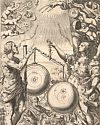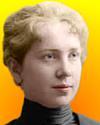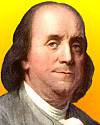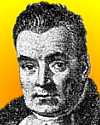 | TODAY IN SCIENCE HISTORY NEWSLETTER - 17 APRIL |
| Feature for Today |
 On 17 Apr 1598, Giovanni Riccioli was born, the Italian astronomer who was the first to observe a double star. On 17 Apr 1598, Giovanni Riccioli was born, the Italian astronomer who was the first to observe a double star.You can read more about Giovanni Riccioli's contributions to Italian astronomy, including his book, Almagestum Novum (1651) in this article from The Penny Cyclopaedia of the Society for the Diffusion of Useful Knowledge (1841). |
| Book of the Day | |
| |
| Quotations for Today | |
 | "I think it is a duty I owe to my profession and to my sex to show that a woman has a right to the practice of her profession and cannot be condemned to abandon it merely because she marries. I cannot conceive how women's colleges, inviting and encouraging women to enter professions can be justly founded or maintained denying such a principle." (From a letter Brooks wrote to her dean, knowing that she would be told to resign if she married, she asked to keep her job. Nevertheless, she lost her teaching position at Barnard College in 1906. Dean Gill wrote that 'The dignity of women's place in the home demands that your marriage shall be a resignation.') |
 | "I say it is impossible that so sensible a people (citizens of Paris), under such circumstances, should have lived so long by the smoky, unwholesome, and enormously expensive light of candles, if they had really known that they might have had as much pure light of the sun for nothing." Describing the energy-saving benefit of adopting daylight saving time. (1784) |
 | (My favourite fellow of the Royal Society is the Reverend Thomas Bayes, an obscure 18th-century Kent clergyman and a brilliant mathematician who) "devised a complex equation known as the Bayes theorem, which can be used to work out probability distributions. It had no practical application in his lifetime, but today, thanks to computers, is routinely used in the modelling of climate change, astrophysics and stock-market analysis." |
| QUIZ | |
| Before you look at today's web page, see if you can answer some of these questions about the events that happened on this day. Some of the names are very familiar. Others will likely stump you. Tickle your curiosity with these questions, then check your answers on today's web page. | |
| Births | |
 |  Giovanni Riccioli, born 17 Apr 1598, was an Italian astronomer who in 1651, he assigned the majority of the current names to features on the Moon. He named the more prominent features after famous astronomers, scientists and philosophers. Giovanni Riccioli, born 17 Apr 1598, was an Italian astronomer who in 1651, he assigned the majority of the current names to features on the Moon. He named the more prominent features after famous astronomers, scientists and philosophers. What general name did he give to the large dark smooth areas of the Moon? What general name did he give to the large dark smooth areas of the Moon? |
| Deaths | |
 |  An American printer and publisher (1706-1790) invented a type of stove, still being manufactured, to give more warmth than open fireplaces. The lightning rod and bifocal eyeglasses also were his ideas. An American printer and publisher (1706-1790) invented a type of stove, still being manufactured, to give more warmth than open fireplaces. The lightning rod and bifocal eyeglasses also were his ideas. |
| Events | |
 |  On 17 Apr 1967, the spacecraft Surveyor 3 was successfully launched from Cape Kennedy, Florida. It was the second US spacecraft to make a soft landing on the moon, where it studied the lunar surface and sent more than 6300 pictures back to Earth. On 17 Apr 1967, the spacecraft Surveyor 3 was successfully launched from Cape Kennedy, Florida. It was the second US spacecraft to make a soft landing on the moon, where it studied the lunar surface and sent more than 6300 pictures back to Earth.  What total number of Surveyor spacecraft were sent to the moon? What total number of Surveyor spacecraft were sent to the moon? |
 |  On 17 Apr of a certain year, Jerrie Mock of Columbus, Ohio, became the first woman to complete a solo airplane flight around the world. On 17 Apr of a certain year, Jerrie Mock of Columbus, Ohio, became the first woman to complete a solo airplane flight around the world.  In which decade was this woman's transglobal flight made? In which decade was this woman's transglobal flight made? |
| Answers |
When you have your answers ready to all the questions above, you'll find all the information to check them, and more, on the April 17 web page of Today in Science History. Or, try this link first for just the brief answers. Fast answers for the previous newsletter for April 16: Wilbur; carbon dioxide; Rosalind Franklin; by accident, through the skin, upon touching its container; pistols. |
| Feedback |
 If you enjoy this newsletter, the website, or wish to offer encouragement or ideas, please send feedback by using your mail reader Reply button. If you enjoy this newsletter, the website, or wish to offer encouragement or ideas, please send feedback by using your mail reader Reply button. |
--
If you do not want to receive any more newsletters, Unsubscribe
To update your preferences and to unsubscribe visit this link


Δεν υπάρχουν σχόλια:
Δημοσίευση σχολίου